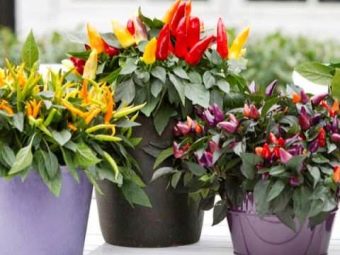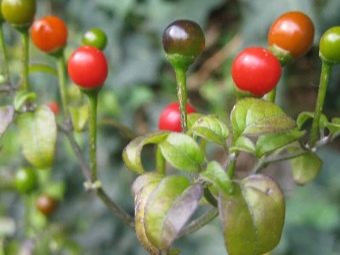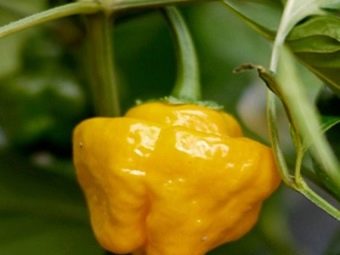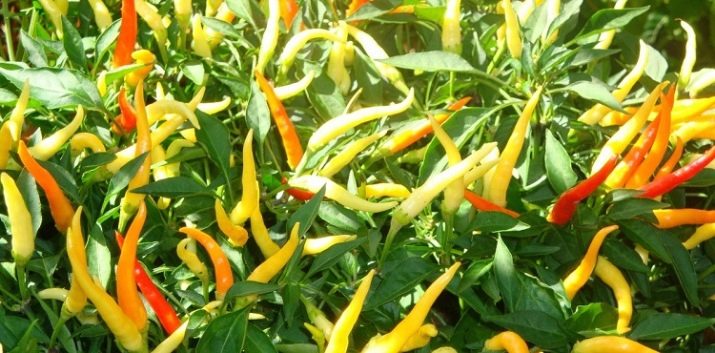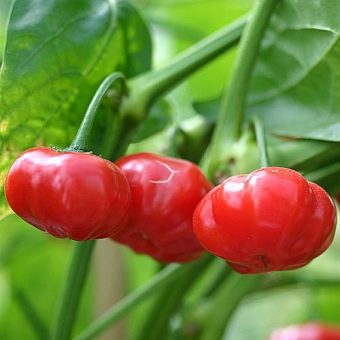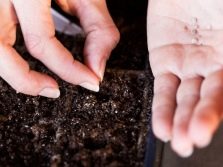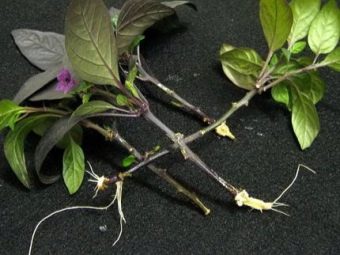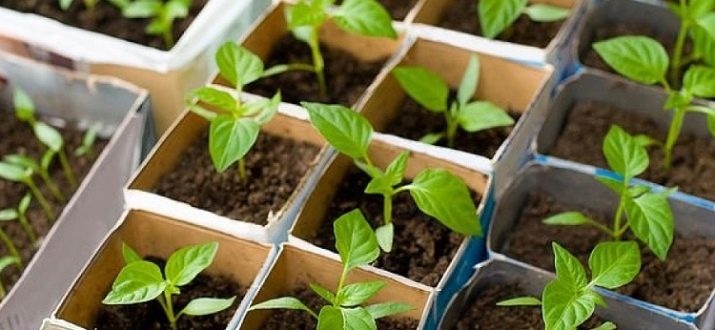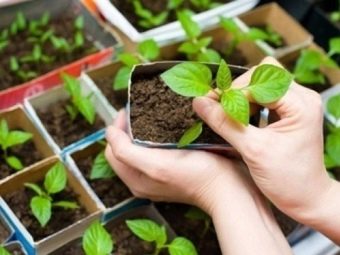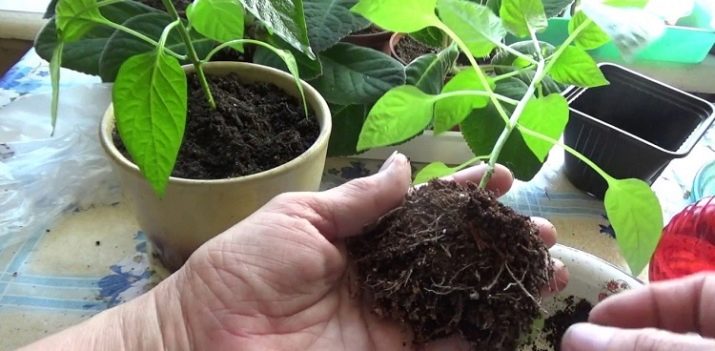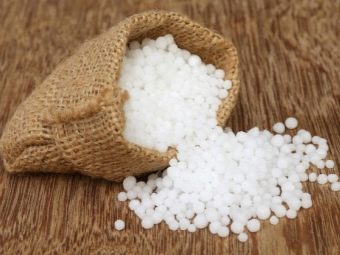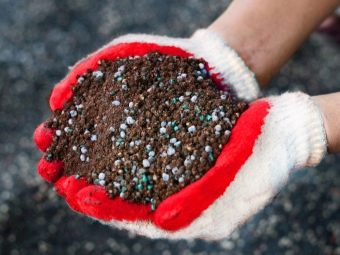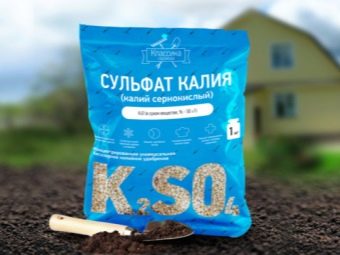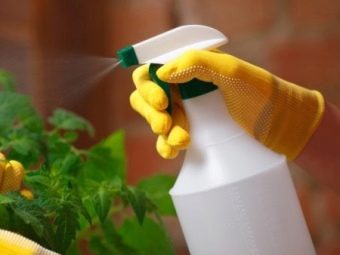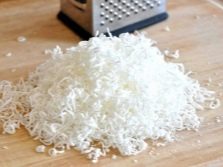How to grow a decorative pepper?
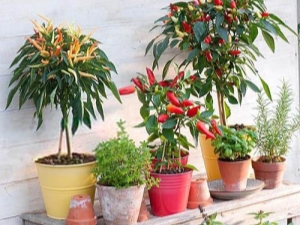
The interest of gardeners to the decorative forms of capsicum - capsicum, due to the attractiveness of its appearance, high yield and undemanding care. Compact bushes or low trees with an abundance of miniature colored peppers are not only spectacular, but also useful living decor for the kitchen. The fruits of capsicum can be used as a spicy seasoning for meat, fish or vegetable dishes and used for canning. In this article we will talk about how to grow and propagate popular vegetable culture.
Variety selection
There is nothing in common between the decorative pepper and the vegetable crop belonging to the pepper family, except for the name and external similarity. Pepper, grown at home, is included in the genus Kapsikum, family Solanaceae. He, like a tomato, is from America.
Varieties
The genus Kapsikum is represented by a large number of wild plants (about 35 species) and several cultivated varieties: pubescent, berry, cayenne, Hainan chili and one-year paprika, so popular in home cultivation. When they talk about indoor pepper, in most cases they mean a plant of the latter type.
Capsicum of different varieties - sweet or bitter with varying degrees of stinginess, is distinguished by its content in the place of attachment of ovules in the ovary of the nitrogen-containing organic compound capsaicin, which is responsible for spice and sharpness in taste. The pulp contains valuable reserves of natural sugar, is saturated with vitamin C, P, beta-carotene and niacin. The green parts of the plant are poisonous.
general description
Chilli peppers of various types are similar in structure, being semi-shrubs with regular simple lanceolate or oval leaves, single axillary flowers and hollow multi-seeded fruits of elongated or rounded shape. The exception is berry pepper growing in the form of a tree.
The height of indoor plants - 15-60 cm, wild species can grow a meter or more. House peppers tend to form fruits and flowers at the same time, which contributes to the enhancement of the decorative effect. Their color can be very different - from intense red, yellow and orange to green, light green, violet and even black.
How to choose a grade?
When choosing varieties of decorative peppers are guided by several criteria.
- Maturation term. Varieties are early, mid-ripening, late. In early maturity the period of full germination to technical ripeness is 65-100 days, in the middle ripening - 100-110 days, in late ripening - 110-140 days.
- Plant height Most home gardeners prefer low, compact, branched, leafy and abundantly fruiting varieties. It is optimal for a house when the height of a plant does not exceed 20-30 cm. Although it all depends on personal preferences. Some owners are delighted with miniature bushes with a height of 15-20 cm, others are not opposed to surround themselves with real giants up to 1 m high.
- The shape and size of the fruit. Varieties can be small or large.
The fruits are impressive variety of forms. In home collections there are plants with short and long, blunt and pointed, slightly curved and even peppers of conical, cylindrical, round and unusual pear-shaped.
- Coloring of foliage and fruits. This criterion is of decisive importance when the plans include growing the plant purely for decorative purposes. In this case, it is worth looking at modern hybrids with pronounced decorative qualities. On the balcony or loggia, hybrid capsicums up to 45 cm high with large leaves of rich maroon-purple color look very impressive. Depending on the variety, the peppers may hang from the bushes, peering out from under the foliage, or, on the contrary, grow upwards, rising above the crown, like tips on peaks.For the hybrid varieties “Medusa” and “Pepperoni”, the formation of elongated wriggling fruits of different colors - red and yellow - on one bush, and the plants of the variety “Masquerade” are colored in three colors - purple, red and yellow. Some hybrids change their color several times during the growing season and finally acquire a yellow, red, orange or cream color only when fully matured. Unusually look variegated hybrids, where the foliage has a heterogeneous color with multi-colored patches in the form of white spots or dashes and lilac stripes, the brightness of which depends on the intensity of solar lighting.
- The degree of sharpness. When hot indoor peppers are grown for culinary purposes, it must be ensured that the selected variety is able to meet the expectations. There are many types of pepper, which are completely devoid of "evil" taste, and there are also those that burn so that their use may be unsafe for an unprepared person.
True gourmets especially appreciate the fragrant peppers “Habanero” - this is a group of varieties that differ in their degree of sharpness and at the same time possess a unique taste and a pronounced floral aroma with citrus notes.
Popular varieties
Find out which choice of varieties of pepper ensures successful cultivation at home.
- "Tepin". Small-fruited variety of wild pepper, referring to the type of annual paprika and famous for its "explosive" spicy taste. At one time, the hot peppers “Tepin” became a real boon for the cowboys, helping to fight sleep on long night duty. Plants with small foliage and miniature bright red fruits up to 1 cm in length are ideal for lively decoration for a window sill.
- "Mini from Brazil". A very rare and valuable decorative form of acute capsicum. Selection work for its removal was carried out using seeds of wild peppers brought from Brazil. The variety attracts the attention with its picturesque small foliage and tiny peppercorns as high as a couple of match heads rising up above the bush. Fruits have a juicy, fleshy, "spreading" pulp. Due to the small leaves of the bushes look light and airy. As in the previous case, the plants are able to decorate the kitchen interior with their presence, making it more expressive.
- Tabasco. One of the classic varieties of cayenne shrub capsicum. Peppers reach a length of 4-5 cm and form bunches directed upwards. Fruits of bright orange color with a reddish shade - this is a mandatory ingredient of the famous sauce of the same name. Their juicy, soft pulp is the key to obtaining liquid seasoning with excellent taste for the main dishes.
- "Salute". This variety is considered the shortest among the decorative forms of capsicum. The maximum height of its representatives is only 15 cm, despite the fact that bright yellowish-orange peppercorns, rising up above the bush, are quite impressive in size. But such a contrast in size looks quite organic, emphasizing the individuality of the plant.
- "Mushroom Yellow." The shape and color of the fruits of this rare variety correspond to the name. Yellow-orange peppers up to 5 cm in diameter, externally similar to mushrooms, have a moderately spicy taste, which makes it possible to use them for stuffing. The peculiarity of the variety “Yellow mushroom” is abundant flowering and fruiting.
- "Spotted Troll". One of the popular high-yielding undersized varieties. Compared with a miniature shrub that grows up to a height of 15 cm, the hanging fruits are large. Another distinctive feature of plants of this variety is a spreading crown with very beautiful variegated foliage. An additional bonus for the owners - abundant fruiting.
- "Black Pearl". Representatives of the Black Pearl variety are impressive for their outstanding decorative qualities and deliver true aesthetic pleasure to their owners. As it grows, the green foliage acquires a thick purple, almost black color. Initially, black peppers have a rounded shape with a slightly elongated blunt tip, and in ripe fruit the color becomes saturated red.
Such a pepper can become a soloist in the flower arrangement on the balcony, loggia or veranda or act as an accent decor in the interior of the kitchen space.
- "Bell". The shape of the capsicum of this variety resembles the graceful flowers of bluebell, only of large size (4-5 cm). When biological ripeness begins, they acquire an intense red color. The combination of sweet taste in “petals” and bitter fruit at the heart allows to get a universal seasoning “2 B1” for meat dishes.
- "Medusa Gorgon". The popularity of this variety is due to the compactness of the bushes, high decoration and excellent consumer qualities of the fruit. Its name explains the appearance of ripe peppers with jellyfish tentacles. On the technical maturity of the fruit shows an intense red color. Due to the spicy taste they are used in cooking and for canning.
- "Raisin Badgio". The aroma of peppers, painted in a rich brown color, slightly gives off raisins, and in the taste there are notes of smoked meat. This delicacy is available in the arsenal of spices of every self-respecting Mexican chef, because from the dried pods they prepare the flavoring bases for all sorts of liquid seasonings for main dishes.
- "Aladdin." Ultra-sharp decorative form of acute capsicum with abundant long-term fruiting. When planting in open ground, bushes covered with small fusiform peppercorns reach a height of 0.5-0.6 m, pot plants are more compact and grow to a maximum of 40 cm. The pods change color as they mature: first it is green Then purple and at the end of bright red, which indicates the technical ripeness of the fruit. Although the place of cultivation does not affect the intensity of fruiting, but outdoor plants are more bitter than room plants.
- "Aji Brazilian pumpkin". A stunningly beautiful hybrid. It is impossible not to notice the bushes with an abundance of scarlet miniature glossy peppers in the shape of a pumpkin and foliage of a rich green color. Fruits with thick-walled skin have a moderately spicy taste.
- "Orange Miracle." High-yielding, early ripe decorative form of capsicum. Biological ripeness occurs in 80-90 days from the moment of germination. The height of compact shrubs - 25-30 cm. The variety is abundant and long fruiting. Due to the unusual color of fruits of ripe orange color, “Orange Miracle” is popular with designers and florists, who include it in their compositions to make them more vivid and cheerful.
Breeding methods
Kapsikum can be grown at home through seedlings or propagated by cutting. Consider the features of seed and vegetative reproduction.
From seed
For growing seedlings, packaged seeds sold by specialty stores and seeds taken from ripe pods are equally suitable. Do not use rotted, darkened or shriveled seed. When buying factory seeds, the periods of storage and sale deserve special attention. Quality seeds of decorative forms of capsicum should be clean, uniform in mass and size, with a smooth protective shell of cream color ..
Pepper seeds have good germination capacity up to 85-90%. Knowing this, some flower growers resort to their dry sowing in the soil. The disadvantage of this method of planting is the low germination rate of seeds, which is why seedlings appear only after 3-4 weeks.Therefore, it is better to carry out pre-sowing treatment of seed by using disinfection, soaking or germination.
For disinfection use the fungicide "Fitosporin-M" or prepare a weak pale pink 0.5% solution of potassium permanganate (0.5 g of potassium permanganate per 100 ml of water) and keep seeds in it for 2-3 hours. After disinfection they are placed in half a day in the water. From emerging non-viable seeds get rid of. Carrying out this procedure allows you to accelerate the germination of seed material, to provide plants with manganese at the initial stage of development and to increase the resistance of plantings to infections.
Old seed well soaked in "Epinay." This powerful phytohormone stimulates seed growth and helps them adapt to stressful environmental conditions - changes in temperature, humidity and light conditions. The solution is prepared at the rate of 4 drops of a biological product per 100 ml of water and the seeds are left in it for 24 hours. Freshly harvested seeds are not required. After any of these procedures, the seeds are immediately planted in a seedling container.
For germination take a wide flat pot and two cotton napkins. They cover the bottom of the plate with a napkin, spread the seeds on it, cover them with a second napkin and pour warm water over it so that it only slightly covers the fabric. Then the container is placed in a warm place, constantly monitoring the level of humidity. After the roots appear, the seeds will be ready for planting in the seedling tank.
Sowing procedure:
- At the bottom of the seedling tank form a drainage layer up to 4 cm thick or make several holes for drainage of water. From above pour a soil mix with a layer of 8-10 cm.
- Carry out the seeding of seeds, deepening them into the ground by 0.5-1 cm. A distance of 3-4 cm is left between the seeds in order not to limit the freedom of growth of seedlings.
- Sprinkle the seeds with a thin layer of soil so that they are completely hidden by the ground.
- Apply an atomizer to moisten the soil. After using it, the primer should remain slightly damp and not wet. Excessive waterlogging of the ground provokes the development of root rot in seedlings.
- To create crops for hothouse conditions, the container is covered with glass or polyethylene and placed in a warm, bright place, not forgetting about regular soil moistening. Seeds actively germinate at t 21-24 ° C. Sunny window sill - a very undesirable place for seedlings. Exposure to direct sunlight contributes to the formation of a greenhouse effect under glass, which is why seeds never grow, simply “boiled” in the ground.
- When the first germs appear, the glass is periodically removed to accustom the plants to indoor air, and the length of the day is increased to 18 hours. If there is insufficient natural light in the place where the seedlings are contained, then light-emitting diodes or low-pressure mercury discharge lamps are used for additional illumination. Lighting devices are suspended at a height of 0.5-0.6 m.
Fresh seed germinates in 1.5-2 weeks. If the seeds are old, then wait for the emergence of shoots have much longer - from several weeks to a month.
From cuttings
Capsicum stem cuttings are best grown from March to April. The cuttings planted during this period have enough time to form a good root system, thanks to which they will start sprouting actively in the summer and will endure wintering better, unlike the cuttings of later planting dates.
Cuttings root in different ways.
- In the most healthy and sturdy shoots of an adult plant with a sharp knife, cut the tops off and place them in the warm water to take root. When cuttings give roots, they are planted in containers of 2-3 pieces.
- Cut off shoots are immediately planted in permanent pots filled with ready soil for solanaceous or independently prepared soil mixture.
- Separated from the stem side shoots.For processing the slices, a root growth stimulator is used, after which they are placed in a soil mixture (sand + earth in equal proportions). Watering the cuttings well, the container is covered with glass or a plastic lid and left in a warm, well-lit place. Once a day the lid is pushed back to ensure the intake of oxygen inside. Pinching tops contributes to the rapid rooting of cuttings. After 3-4 weeks they can be moved to large pots with the preservation of earthen coma.
When cultivating in an apartment, one can expect a high yield of decorative pepper only during the first 2-3 years. After this time, the productivity of the plant inevitably decreases. Sometimes such a nuisance occurs with peppers under the influence of stress factors during wintering (lack of light, dry air in the room) or because of too abundant fruiting during the first year of life.
Growing fresh seedlings takes time and effort. It is much easier, and more profitable in terms of saving money for the purchase of high-quality seed material, to cutting a plant, especially if it is a rare variety.
The value of pure varieties is in certain qualities - the color of the fruit, the height of the bush, taste, etc. Thanks to vegetative reproduction, you can save a set of biological properties and characteristics of the mother plants.
Landing rules
There is nothing difficult in the agricultural technology of decorative pepper, but to get a beautiful, healthy and abundantly fruiting plant, you will need to comply with a number of conditions. Consider step by step how to grow capsicum in an apartment.
Timing
Planting pepper can be planted throughout the year, given the characteristics of the cultivated variety.
The most favorable time to disembark:
- early spring varieties - from the first days of November to the end of December;
- summer varieties - from the beginning of March to the last days of April;
- late varieties - from July to the end of August.
When podzimny sowing will require the organization of additional highlighting of seedlings.
A place
For decorative pepper, as a photo-loving crop, it is important that the room where it is planned to grow it is sufficiently ventilated and have good natural light. The best option is a room oriented to the east or west. It is undesirable to place a pot with a plant on the window sill in a room with windows facing south. In the midday hours the sun is especially aggressive, and the gentle foliage of Capsicum may suffer from burns. If the pepper grows on a very sunny, glassed-in balcony, then at the height of the day it should be shaved to avoid heat shock from an excess of direct sunlight.
However, for the full growth and development of pepper requires regular exposure to sunlight. In spring and summer, and in good weather, the plant can be put up on the balcony in the morning in order to bask in the sun for 3-4 hours. The optimum temperature for sunbathing is –20-22 ° C. The shelves and cabinets in the back of the room, as well as the refrigerator in the far corner of the kitchen, are extremely unsuccessful places for placing "lights". The lack of sunlight adversely affects the state of capsicum, which is expressed in poor tillering, poor flowering and fruit formation. Insufficient natural illumination of the room is a reason for the additional use of artificial light sources.
With the onset of cold weather, when the length of the day is rapidly decreasing, it is artificially prolonged up to 10-12 hours with phyto- or luminescent lamps. If this is not done, the pepper may weaken or die due to stress caused by a lack of light. It is important to remember that when the conditions for the maintenance of southern plants are far from the conditions to which they are accustomed in their homeland, their immune system is not always able to cope with the effects of adverse factors.
The soil
Land for planting should be loose, porous, light, and preferably with neutral acidity (optimal pH values are 6.45-7.0). Staying in dense soil with a high clay content of this culture is contraindicated. It is important to use fertile soil with good water holding capacity and water holding capacity, enriched with organic fertilizers.
The ornamental pepper is suitable for ready-made nutrient mixture for solanaceae, but it feels best of all in a self-made substrate, including coarse-grained river sand, humus and leaf soil in a 1: 2: 2 ratio.
Adding peat helps to improve the structure of insufficiently aerated earth, so that it will better absorb and retain moisture. The use of expanded vermiculite or agroperlite also increases the exchange moisture of the soil.
Disinfection
Capsicum seedlings are often affected by the black leg, a dangerous fungal disease that causes the death of young plants. If the purchased soil substrate is already disinfected, then the soil prepared by yourself must be cleaned from larvae and pathogenic bacteria before planting.
There are several methods of disinfecting soil mixture for planting.
- Steam treatment. The earth in a saucepan with an airtight lid is steamed for 2 hours in a water bath over low heat until the water boils away. The procedure is carried out a month before the landing work.
- Glowing Soil mass in a uniform layer of 4-5 cm poured on a baking sheet and left in an oven sterilized for 20-25 minutes, putting t 100-150 ° C.
- Strait of manganese solution. Prepare a solution of potassium permanganate in the ratio of 0.5 g per liter of water and watered the soil. Do this for 1.5-2 weeks before sowing.
- Chemical processing It is possible to disinfect the substrate by highly effective fungicides such as Fitosporin, Barrier, Planrizom, Glyocladin or insecticidal agents - Thunder, Aktara, Iskra.
The use of chemicals requires strict adherence to the concentration and consumption of the drug, recommended by the manufacturer.
Pot selection
As practice shows, ornamental peppers willingly and abundantly bear fruit in pots, matched exactly to the size of the roots, and staying in a little cramped capacity does not affect their well-being. Proper cultivation of Capsicum involves updating the pots as the above-ground and underground parts of the plant grow. For the first transplant to a permanent place for young plants, small pots with a volume of up to 300 ml are sufficient. If you immediately put them in a large container, then watering will provoke acidification of those parts of the soil that the roots have not yet mastered.
Sampling and transplanting
Pick seedlings in individual pots perform when they release these leaves in the amount of 2-3 pieces. To avoid damage to the root system, seedlings are transferred by transshipment with preservation of earthy coma. When picking, the seedlings are not buried, but placed at the same level that was in the seedling tank. Deep planting, as well as excessively wet substrate or cold content, increase the risk of root rot.
By the way, the pepper does not need deep embedding at all. It has a peculiar root system without additional roots, like that of its closest relative - tomato. Due to this, the root system of tomatoes quickly regenerates and recovers even after serious damage. Pepper does not have such an ability, therefore a strong penetration of the root collar during transplantation may cause a halt in its development. This is at best, and at worst - the plant will fall ill.
The procedure for transfer work.
- At the bottom of the planting tank they form a drainage layer of coarse sand, pebbles, broken small shards up to 3 cm thick.
- In order to prevent the drainage mixture from blocking the holes for water flow, the bottom is covered with a crock of ceramic dishes with the convex side upwards.
- Pour the pre-prepared soil mixture into the pot and place the seedling in it. It is possible to produce a pinch of the main root so that the side roots are formed more actively and a powerful root system is formed. Then you need to evenly distribute the seedling around the seedling and compact it using a thick wooden stick.
- After planting, the soil will remain well moistened with warm water.
Rooting seedlings do not need to be watered. Not rooted roots have no ability to absorb excess moisture, so watering can cause them to rot.
Capsicum is transplanted annually, partially replacing the soil to increase its nutritional value. Since the manipulation of the roots causes the strongest stress in this crop, some plant growers replace the soil without removing the plant. Favorable time for interchange works - the middle of winter.
Care features
To look after burning handsome men is quite simple. Special attention and care is required only for young plants. Further care of the pepper is reduced to a complex of measures, which is standard for habitual indoor cultures, aimed at creating and maintaining conditions for its full growth and development.
Temperature conditions
Kapsikum grows well at a moderate ambient temperature of 23-25 ° C in the spring-summer period and 17-19 ° C in the winter season. This culture loves fresh air, so you need to regularly open the windows for airing, closing the room, so as not to make drafts.
If in winter and autumn the plant is not additionally illuminated, then a cool temperature within 14-16 ° C is maintained indoors, while reducing the frequency of watering.
With the onset of summer, it is desirable to move pots with pepper from a room to a balcony, loggia or veranda. The plant favorably relates to day and night temperature extremes and feels great outdoors.
Watering
In the care of capsicum, which is a moisture-loving culture, regularity of watering and spraying the crown is of great importance. But if tomatoes tolerate the drying of an earthen coma, then the peppers in this regard are very capricious and will react to such changes in keeping conditions by dropping foliage, weak flowering and lack of fruits.
The irrigation regime should be such that the soil always remains moderately wet. Its waterlogging also negatively affects the state of landings, as well as the lack of water. When the relative humidity of the air in the room is reduced to 50-55%, the decorative chilli is sprayed with a spray gun twice a day. Water the plant and moisten the crown with distilled water t 25 ° C.
Top dressing
Chilli pepper is very responsive to balanced dressings. This culture is developing correctly, it abundantly bears fruit and retains its decorative effect provided that the soil is enriched with essential nutrients in a timely manner — nitrogen (N2), phosphorus (P), potassium (K). Determine the lack or excess of these elements can be on the appearance of the plant.
The bright foliage of burning handsome - a clear sign of nitrogen deficiency - the most deficient nutrient for any plant. Green organisms consume nitrogen in economy mode. Its bulk contains the atmosphere and most of the representatives of the plant world N2, having a gaseous form, is not available. Nitrogen is formed in the earth due to the input of organic residues and the work of nitrogen-fixing bacteria involved in soil formation. Lack of N2 causes delays in the growth and development of plants. If the peppers begin to actively grow the vegetative mass, but do not bloom, then this reaction indicates that the soil is oversaturated with nitrogen as a result of a wrong diet.
If the foliage in the lower part of the bush becomes purple in color, then it is time to feed the plant with phosphorus. Lack of this vital element negatively affects the process of development of generative organs from flowering to fruiting. If you do not fertilize, the only source from which phosphorus will fall into the ground will remain the parent soil-forming rock. In this case, the plant, this element will be available only in small quantities.
Potassium enters the active part of the soil and to plants from colloids and small fractional natural rocks of various origins. Lack of potassium causes the death of plants. Due to the lack of this substance in the decorative pepper development is impaired, which is reflected in the weak color of the fruit and too long ripening.
Diet
Mineral complexes are introduced every two weeks in the spring-summer season, and with the arrival of winter, the frequency of fertilizing is reduced to 1 time per month.
For these purposes, commonly used drugs are commonly used in crop production:
- double superphosphate at the rate of 3-4 g per 1 l of water;
- potassium sulfate (potassium sulfate) in the ratio of 2-3 g per 1 l of water;
- ammonium nitrate in the dosage of 1.5-2 g per 1 liter of water.
When choosing fertilizers with one or another active component in the composition, the developmental phase of the green organism becomes the decisive factor. Calcium is especially important for actively growing plants, therefore calcium nitrate (calcium nitrate) is introduced into their diet. For foliar fertilizers prepare a solution at the rate of 2 g of agrochemical per 1 l of water.
When the pepper prepares for flowering and lays the buds, it needs enough nitrogen. During this period, the bushes are sprayed with a solution of nitrogen-containing fat. To stimulate the root system in the phase of fruit formation, emphasis is placed on fertilizing with phosphorus-potassium fertilizers, for example, “Nitrophos”. In this mixture there is a high phosphorus content (16%), which is required by Capsicum at the final stage of seasonal development.
When growing decorative forms of pepper, such a common agricultural application as alternation of mineral dressings with organic matter is relevant. As an organic fertilizer flower growers often use granulated bird droppings. A liter jar of litter is diluted in 30 liters of water. Organic fertilizers must be applied to well-watered soil. Otherwise, the root system of green pets may suffer from burns.
Recommendations
Particularly decorative indoor plants look in the phase of fruit formation, when the bush is covered with miniature colored peppers. Thanks to the systematic shaking of a flowering shrub, it will begin to form the ovary more actively. A similar result can be achieved if from time to time to walk through the flowers with a voluminous brush with a soft nap.
It is believed that the joint planting of hot and sweet pepper varieties is unacceptable. Allegedly, this leads to a “pereoplation” of sweet pepper, as a result of which it acquires a bitter taste. In reality, the situation is different. Peppers in fact tend to pereopyla. However, the first harvest will be sure to have the taste of the variety. The fruits of capsicum are false berries formed by maternal tissues - the placenta with the pericarp, because they will have a taste in full accordance with the variety. And only next year, a close neighborhood of sweet and hot peppers can lead to a change in taste. Therefore, those who use exclusively factory seed for the cultivation of ornamental pepper can plant annual paprika with hot cayenne chillies without fear of surprises.
Bushes with bright peppers invariably attract the attention of others, and especially children like them. The task of adults is to tell the child that the taste of the fruit is bitter, caustic and, most importantly, it strongly burns the lips, tongue and throat. Therefore, tearing, and even more, there are cute peppers is unsafe and in general there is no point, so they are “tasteless”.If such a “toy” falls into the hands of the child and he then begins to rub their eyes or lick the fetus, then such experiments will end with intense irritation of the conjunctiva of the eyes or oral mucosa.
Room peppers not only serve as an interior decoration and help cooks to make food tasty, but also do an excellent job with the task of bactericidal air cleaning. In rooms where this culture begins to grow, much less pathogenic microbes become over time.
Thanks to capsaicin, a phenolic compound accumulated by the placenta, members of the Capsicum genus can be effectively used to control phytophages (aphids, spider mites). To do this, hot peppers are ground in a meat grinder, poured warm water in a ratio of 1: 10 into a container with the resulting mass, and kept for a day. Filter and add the solution of soap chips (1 g of soap per liter of water). Damaged plants are sprayed three times with a 5-day interval between treatments.
How to grow a decorative pepper, see the next video.


